 She was bound to have trouble. 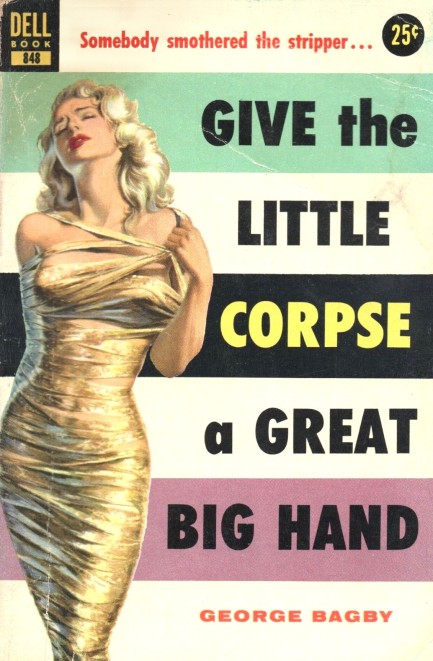
1953's Give the Little Corpse a Great Big Hand by George Bagby, aka Aaron Marc Stein, is a murder tale in classic whodunnit style about a burlesque performer named Goldie Gibbs who's debuting a routine at the famed but fictive Limehouse Club in which she's wrapped like a mummy and carried onstage in a golden coffin from which she rises and strips. Unfortunately, Goldie never rises because she's been murdered. On the case is New York City homicide inspector No-First-Name Schmidt.
Schmidt had been a franchise character for Babgy since 1936 and would eventually star in fifty-plus novels, the last in 1983. Here he cycles through various suspects with incisive questioning, and soon finds links between the murder, the local organized crime kingpin, and a spate of jewel robberies that happened the same night, while also learning that a colleague's daughter who sings at the Limehouse Club has some connection to the crime—unwittingly, beyond a doubt, because she's a “sweet kid.”
This and the other Schmidt books are narrated not by the inspector, but by a journalist named George Bagby—yes, same as the author—who publishes the tales in a magazine. From first person point-of-view Bagby gives readers the procedural details of the case, while also admiring his friend's great intelligence. Give the Little Corpse a Great Big Hand is mostly interrogations and speculations. While we've grown to prefer authors who build books a bit more around action, Bagby/Stein's all-brains approach works fine, and for whodunnit fans we'd call this a necessary read.
Moving on to the cover, it was painted by Victor Kalin and it's a nice effort, capturing the doomed Gibbs' shimmery gold mummy wrapping as described in the text, but taking a non-literal approach otherwise. We guess painting a dead woman in a coffin wasn't considered enticing, so Kalin came up with this moment that doesn't occur in the story but mirrors her distress. He made the right decision, and the result is eye-catching, as usual with his work. Check here, here, and here for examples.
 Africa gets extra hot in Garnier jungle drama. 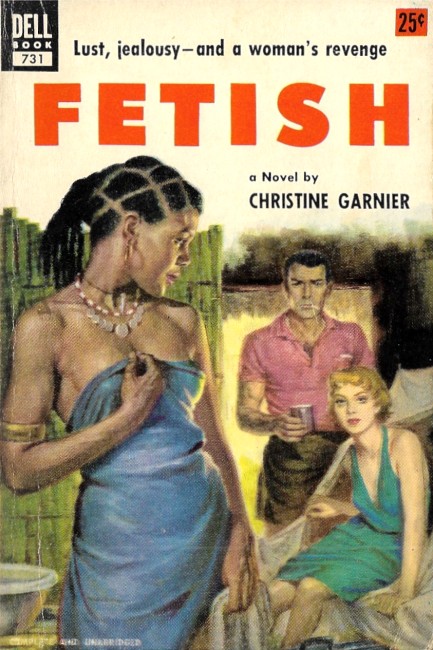
Once again we've been drawn to literature set in Africa, this time in the form of Christine Garnier's romantic drama Fetish, originally published in 1951 in French as Va-t'en avec les tiens! Our edition is from 1953, published by Dell, translated into English, and bearing excellent cover art by Griffith Foxley. The rear cover is interesting as well, particularly because Dell toplined a middling review from Time magazine after molding it into glowing praise: As stirring and authentic as a native dance... throughly convincing... effective... flashing. What the review actually said, in part, was: Garnier [combined] her minor talent for fiction with her knowledge of African life. The result was Fetish, a novel which sold a phenomenal (for France) 135,000 copies. Garnier still lacks skill as a novelist, but in Fetish it scarcely seems to matter. The book's main virtue is its French West African background, as stirring and authentic as a native dance.
Okay, Time magazine can take a flying leap. Garnier can write just fine. Fetish is about a Westernized African woman named Doéllé who works in the Manoho district of Togoland as a nurse for a French doctor. She has a white lover named Flavien who's a local magistrate. When the doctor's hot wife Urguèle arrives from Paris, every white man in the district—including Flavien—desires her. Doéllé is likewise thought by all to be quite a dish. But she isn't white. Urguèle's easy assertion of privilege, and her husband's eventual realization that she wishes to stray, sets up a dangerous love rectangle that propels Doéllé toward—let's say—locally traditional solutions for the problem, despite her education and Westernization.
Fetish avoids some pitfalls of mid-century novels written by whites about Africa. Actually, “avoid” makes it sound conscious. Garnier is simply a sensitive writer, and because the story is narrated by Doéllé, it lacks some of the usual arrogance toward its setting. Time noted that authenticity is a strength of the book, and that's correct. One aspect of this authenticity that goes against the grain of every book we've ever read set in Africa is that, according to Garnier, it was impossible for whites to have a secret affair. Africans were so fascinated and mystified by these pale aliens, as well as wary of them, that they never left them unobserved, and shared everything seen and overheard. Even barred from places, they still noted all who came and went where they themselves weren't allowed. That extreme lack of privacy rings true to us, due to our many experiences as foreigners in tropical hamlets.
As we said, Doéllé narrates Fetish, and because she's acquainted with so many native children and servants in Manoho, she's the beneficiary of all their observations, eavesdropping, and gossip, as described above. The book's point of view shifts between first person, to third person filtered through the many eyes and ears of the district, and even farther, as Doéllé extrapolates Urguèle's, Flavien's, and others' innermost thoughts and musings. In practice she's a first-person, limited-third-person, and unlimited-omniscient narrator. We thought that was a nice trick by Garnier. So Fetish has authenticity, atmosphere, star-crossed lovers, and a good story, all well woven. Time can get bent. Was the book pulp? Not really, but there's passion and danger, and we found it enjoyable.
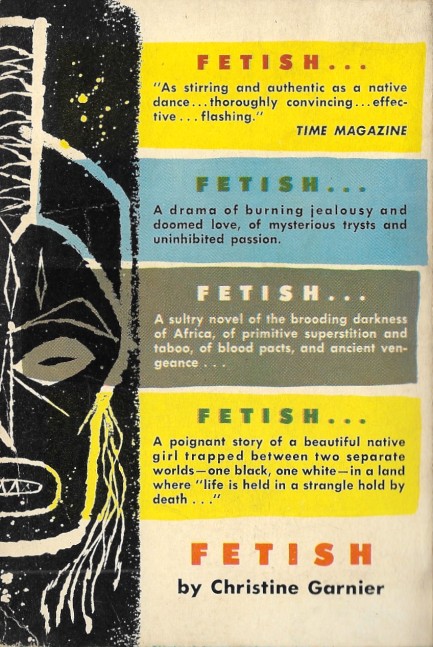
 If nobody answers you're about to find a body. 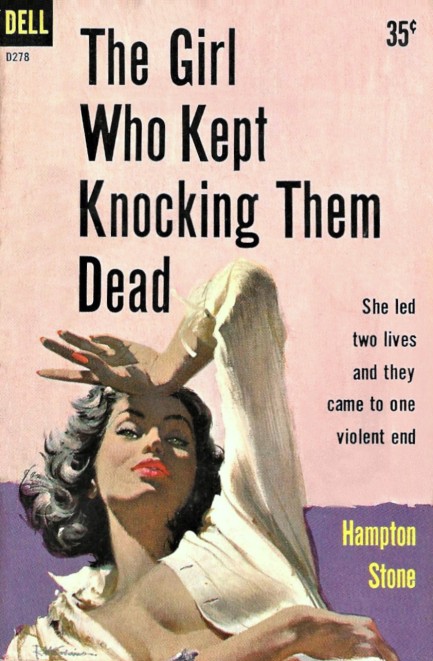
Above is Robert McGinnis cover art for Hampton Stone's 1957 novel The Girl Who Kept Knocking Them Dead, which is basically a crime procedural, told from first person perspective by an assistant D.A., but focused on the narrator's capable partner Jeremiah Gibson. The saga begins with the strangulation murder of a New York City woman who had been leading a double life. That murder leads to others, as the mysterious killer tries to cover his or her tracks. The title of the book is a potential misdirection play. You expect the killer to be one of the female characters, but there are men who might be guilty as well. Overall, the tale isn't compelling, but that isn't an issue with writing skill, so much as voice. It's too limited. Stone's narrator isn't interesting. His genius investigator Gibson is, but with everything filtered through the admiring partner's recollections the tale never takes flight as it might have. We probably won't try Stone again, but he wrote a lot of books, so you never know.
 Wake-up calls at the Hiltons' are murder. 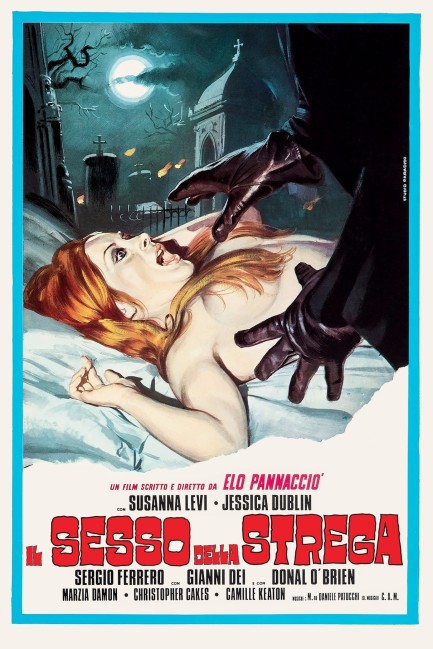 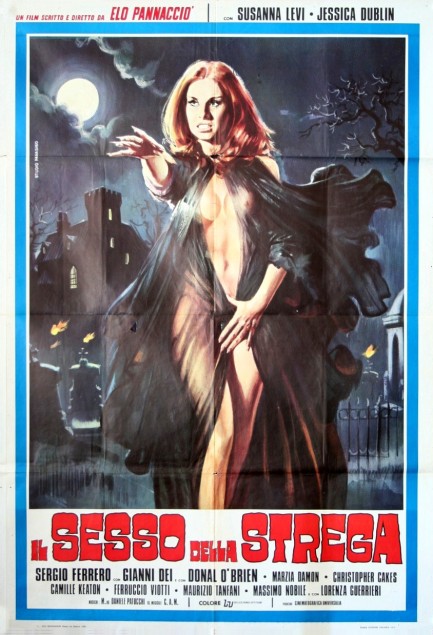
We were drawn to Il sesso della strega, aka Sex of the Witch, because of its excellent posters painted by Lamberto Forni, an artist whose work you've seen here before. But as often happens, the movie didn't live up to the promo imagery. The strange tale begins with Sir Thomas Hilton, a wealthy wine grower, who dies of old age. His family gets a surprise when the will is read: all those closest to Hilton, including his secretary, benefit from the profits of his holdings, but nothing can be broken up or sold, his sister gets nothing, some heirs don't benefit immediately, and if anyone dies their share is distributed among the others. Basically, the will is a blueprint for the Hiltons to start murdering each other. When that happens, the spurned sister is suspected of being a witch. But is she?
None of it matters. The movie is an merely excuse for a lot of overlong softcore sex scenes of the worst kind. You know the ones we mean—interminable slow wriggling devoid of even a hint of erotic heat. You have to really drop the ball to make naked people boring—especially naked Italian women from the ’70s, with their enormous bushes*—but director Angelo Pannacciò, aka Elo Pannacciò, accomplishes that here, in his debut. It's impossible to care about the movie's central mystery, and despite Pannacciò somewhat giallo visual stylings there's just nothing to get enthusiastic about. Except those posters. Nice work, Forni. Il sesso della strega premiered in Italy today in 1974.
 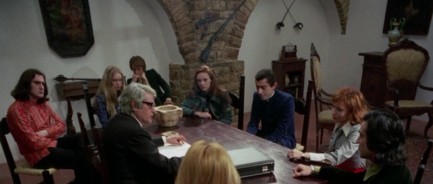  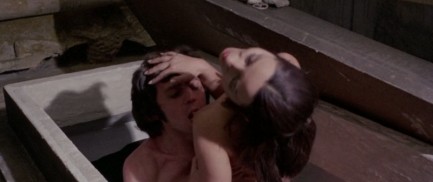     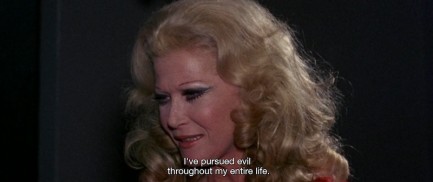   *We love enormous Italian bushes, both tactilely and visually. This one is large, but not stupendous. You know when a bush is really big? When the moment it's revealed you think there's suddenly been a citywide blackout.   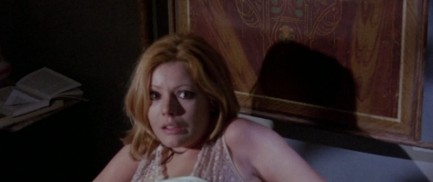
 Mwah! I love you left hook. You get it done every time. 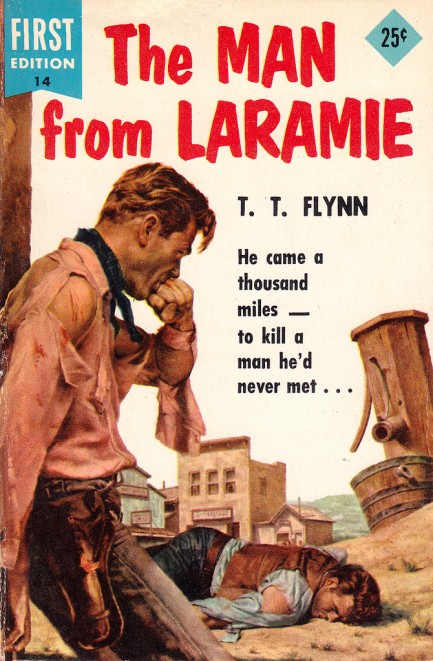
1954's The Man from Laramie by T.T. Flynn is fronted by Stanley Borack art featuring a standing figure nursing sore knuckles, but we prefer to think of him as gratefully kissing his fist. You get a couple of archetypal western elements in this novel, most importantly the mysterious stranger from out of town, and the powerful rancher with no scruples. If the title sounds familiar, it's probably because the book was made into a hit 1955 movie with James Stewart. We may have a look at that later.
 Some actresses consider it a role to die for—literally. 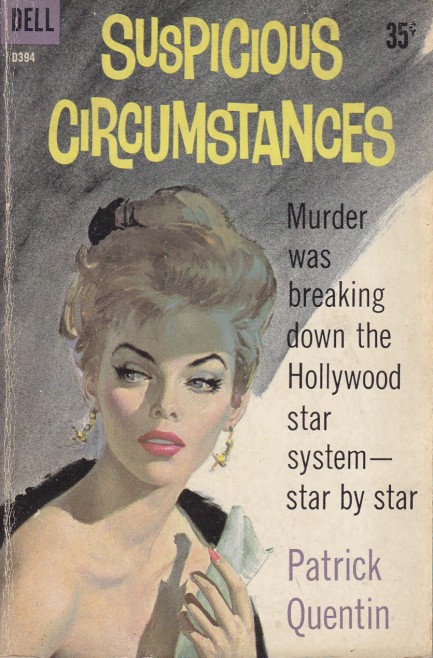
This is a beautiful Robert Maguire cover, somewhat different from his normal style, that he painted for Patrick Quentin's 1957 mystery Suspicious Circumstances. Quentin was a pseudonym used by various authors, but in this case Hugh Wheeler was behind the façade. The cover blurb describes murder breaking down the Hollywood star system, and that's basically what you get, as the book centers around nineteen-year-old Nick Rood, nervous son of globally adored actress Anny Rood, and follows his suspicions that his mother has killed in order to steal a plum movie role. The book is written in amusing and affected fashion, and is filled with characters speaking in ways no humans do, or likely ever did:
“It's positively Greek. Sophocles would purr. Aeschylus would run not walk to the nearest papyrus or whatever he wrote on.”
How very arch. Thanks to various crises, third party manipulations, and suspicious deaths, the coveted film role repeatedly falls into and out of Anny Rood's lap, while fragile Nick flips and flops from suspecting his mother of murder to not. Meanwhile a newcomer to the entourage, a young secretary named Delight Schmidt, turns Nick's head with her beauty and sweetness, but may be just ambitious enough to have a hand in everything that's occurring. Mid-century authors seem addicted to portraying Hollywood in comical or farcical fashion, but we can't argue with the results here. Suspicious Circumstances is well written, generally interesting, and occasionally funny as hell.
 No man who dumps her ever lives to regret it. 
 One day there will be no more Charles Williams for us to read, and that'll be sad, but his books, like good wine, are something you have to treat yourself to regularly even as the stock dwindles. His 1958 novel All the Way, which is the source material for the 1960 movie The 3rd Voice, is typically solid Williams work. One day there will be no more Charles Williams for us to read, and that'll be sad, but his books, like good wine, are something you have to treat yourself to regularly even as the stock dwindles. His 1958 novel All the Way, which is the source material for the 1960 movie The 3rd Voice, is typically solid Williams work.
It has a fascinating plot at its center. A vengeful woman enlists a fugitive to help her steal her former lover's identity, then impersonate him for weeks afterward so nobody will suspect when he disappears that she's actually killed him. The reason people are supposed to assume a disappearance instead of murder has to do with paranoid schizophrenia in the ex-lover's family, and the fact that the fugitive impersonating him has been faking its rapid onset, publicly and loudly.
With the ground laid in this way, a disappearance will be the logical conclusion, and since the man is rich, the fact that a hundred seventy grand is missing from his bank accounts merely indicates he's never coming back—not that an imposter has withdrawn the cash. The scheme is convoluted, but the genius femmes who come up with them are a staple of pulp literature. Williams gets the job done again, as does Ernest Chiriacka, who painted the cover art.
 Fontaine returns for another deadly installment of the hunger dames. 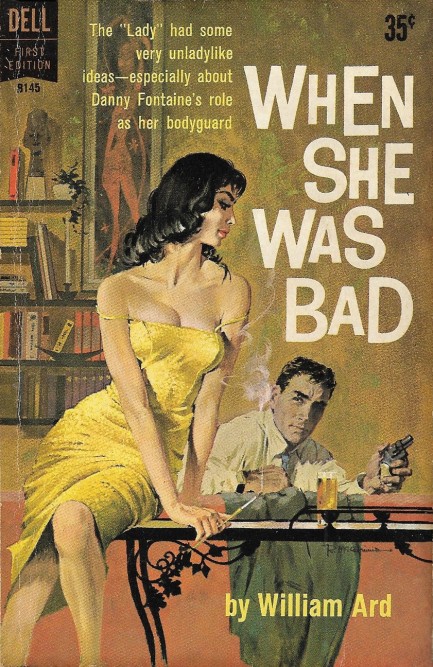
It's official. William Ard, in all his incarnations, is a trusted author. In 1960's When She Was Bad, the follow-up to 1959's As Bad As I Am, Danny Fontaine is now a fledgeling detective on his first case. Many mid-century detectives are ladykillers, but Fontaine is on a level that silences rooms when he enters. He's what women these days might amusingly call a “dilf”—a detective I'd like to fuck. His job is to locate a missing minor royal, a thrillseeker who's caused a ruckus from Grand Bahama to New York City but now may be in trouble way over her head. Fontaine mixes with women ranging from a marquess related by marriage to the Queen of England to a trio of top rank call girls, and they all fall hard for him. His efforts to earn his wings as a private operator under these circumstances are often funny and always exciting. Simply put, Ard's got skills. The cover art on this Dell edition is by Robert McGinnis, and he's got skills too.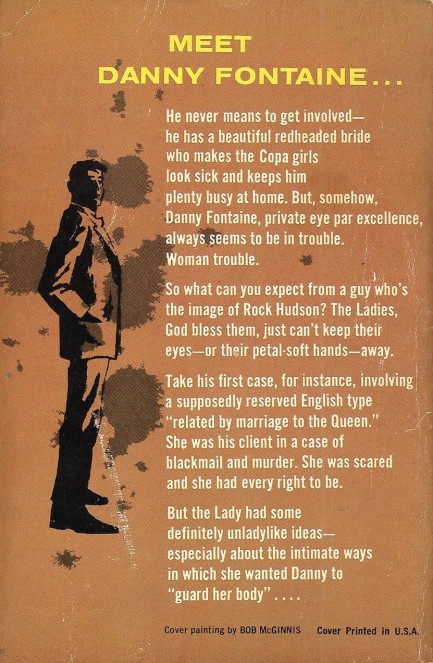
 Intelligent, thoughtful, scalding hot—what's the catch? 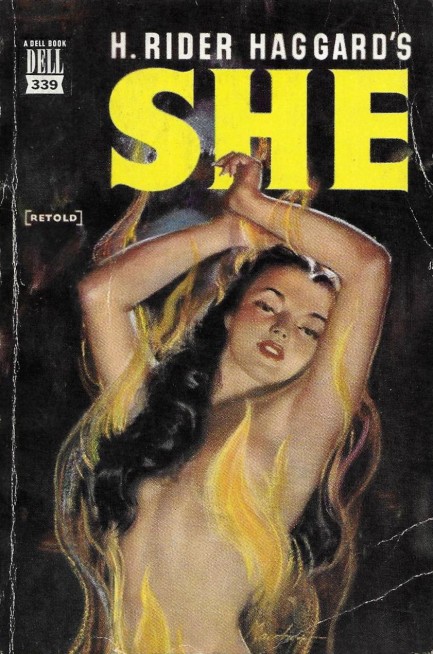
H. Rider Haggard's novel She is one of those rare fantasy/sci-fi novels that has been widely read through three different centuries. A pre-pulp novel, it was originally published in 1887, retained popular interest through the pulp era when it was made into a 1935 movie starring Helen Gahagan, continued generating interest through the mid-century paperback era and into the 1960s, when it was adapted with Ursula Andress in the lead role, and remains available in bookstores and from digital booksellers in the 2020s. The book has enjoyed such longevity because it's a well-written and archetypal lost world adventure with all the elements that sub-genre requires: intrepid explorers in an exotic land, savage encounters with locals, a central quest for something thought to be priceless or unobtainable, and a temptress at the center of the narrative.
The temptress, Ayesha, is an ancient but youthful countenanced woman of Arab descent who has discovered the secret to long life, but who's lost her true love along the way and awaits his reincarnation. She lives in a lost realm called Kôr amidst a host of Africans, who she hates, but rules while she pines for her dead lover to return. Two thousand years after his death, his direct descendant undertakes an expedition to the African interior, where he and Ayesha are destined to meet. This descendent, Leo Vincey, accompanied by his mentor and friend Horace Holly, has been handed down a story through the generations of an immortal woman who murdered his forebear. His quest is to find if such a fantastic story can be true, and possibly take revenge for his entire bloodline.
Haggard is good with descriptive passages, but what's equally interesting is that the book is partly procedural in nature, with long transcriptions of Latin, Arabic, and Greek, and an abundance of academic discussion. Eventually the tale centers around Ayesha's belief that Leo Vincey is her dead lover returned to her, which means her African vigil is mercifully at an end. Her plan? To go to England and rule it with Leo. She'll have to depose Queen Victoria to make that happen, but since she possesses advanced if not magical powers, she considers that no biggie. While we'd have loved to see the story head in that direction, obviously nothing written during the Victorian Age is going to involve a plot to destroy its eponymous figurehead. But what fun that would have been.
On a less fun note, and at risk of stating the obvious, books of this sort are culturally blinkered. The writers depict dark-skinned peoples as savage and deadly, though white-skinned peoples had by then ravaged the entire world, killing hundreds of millions upon hundreds of millions of people for no other reason than greed. This dismissal of non-white lives is exemplified when Horace Holly explains to Ayesha, who hates monarchs, that the nature of royalty has changed during the centuries of her self-imposed exile, and that Queen Victoria is, “venerated and beloved by all right-thinking people in her vast realms.” You have to smile at this, considering the British Empire was an industrial killing machine. Possibly Haggard wasn't aware of that back in 1887, but do any right-thinking people doubt he'd have ignored it even if he'd known?
It's a given that books such as She overlook or deliberately obscure these truths, therefore, if you crack one open, presumably you've made the decision to go along for the ride. While the book's cultural conceits will annoy some readers, it's worth noting that Ayesha's two thousand years of longevity provide Haggard the opportunity to espouse at least a few views unusual for the era, for example when she drops this nugget: “I have long seen that democracies, having no clear will of their own, in the end set up a tyrant and worship him.” Ayesha is Haggard's narrative savior, in our view. She's by far the most engaging character. Though he portrays her as ignorant due to her long sequestration, some of what she says is pretty damn insightful and ironic in 2023. It helps make She a little easier to swallow.
However, the flipside of Ayesha's sometimes intriguing opinions is that she's long-winded. You'd think two-thousand years of life would make her economical with words, but no—the woman can really beat a dead horse. Actually, so can Horace Holly, who narrates via a letter sent to a friend. These aren't dealbreaking flaws, merely ones to be forewarned about. They make the book many pages longer than it need be. And perhaps another small issue is that there aren't many surprises in the story—Holly's narration, being basically epistolary in nature, constantly hints at tragedy, and every plot turn makes a racket galloping at you from a great distance. But She is still good stuff from Haggard, and is a literary landmark for discernible reasons. This edition came from Dell Publications in 1949 with Lou Marchetti cover art.
 Crime capers of the rich and infamous. 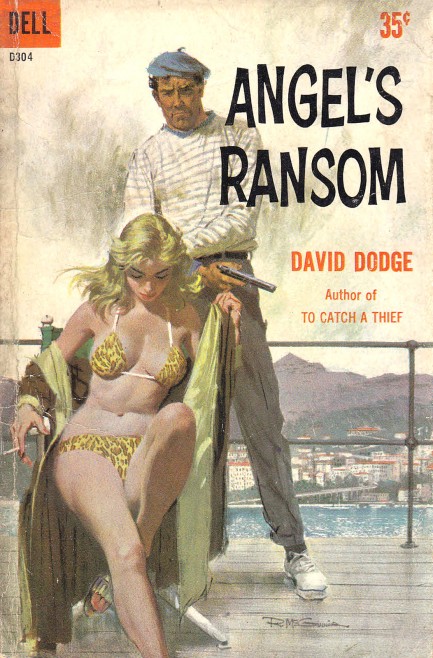
David Dodge's 1956 novel Angel's Ransom takes place in the principality of Monaco, a part of the world the author knew well, along with the rest of the French Riviera. Authentic local details distinguish this kidnapping and ransom thriller, as a group of crooks snatch a yacht called Angel and try to shake down its flamboyantly wealthy owner for 3.5 million francs. Unwillingly along for the ride are the boat's captain, a beautiful guest, a playboy and his distinguished wife, and a Paris showgirl dragged into the plot to assist the criminals. The crooks force the yacht owner to write a bank draft, send a man to Geneva with it, then take the boat out to sea to await word that the draft has been honored. If anything goes wrong, everyone gets to be fish food.
Dodge is a great writer, and this one is good too, though slightly less perfect coming from the master of international intrigue, due to the simple reason that setting most of the action on a boat confines his normally free ranging fiction. But the book is still well written and masterfully paced, with an array of diverse characters to sustain reader interest. If you're going to read any Dodge novel set in this diamonds and champagne milieu we recommend To Catch a Thief—of course—over Angel's Ransom, but you could do far worse than to read any of his international thrillers, including this one. We'll be returning to Monaco with Dodge. He wrote an entire travel book about the French Riviera, ironically titled (because he was a budget traveller), The Rich Man's Guide to the Riviera. We have it and will report back later.
 |  |
|
 |

The headlines that mattered yesteryear.
1920—Negro National Baseball League Debuts
The first game of Negro National League baseball is played in Indianapolis, Indiana. The league, one of several that would be formed, was composed of The Chicago American Giants, The Detroit Stars, The Kansas City Monarchs, The Indianapolis ABCs, The St. Louis Giants, The Cuban Stars, The Dayton Marcos, and The Chicago Giants. 1955—Williams Wins Pulitzer
American playwright Tennessee Williams wins the Pulitzer Prize for Drama for his controversial play Cat on a Hot Tin Roof, which tells the story of a southern family in crisis, explicitly deals with alcoholism, and contains a veiled subtext concerning homosexuality in southern society. In 1958 the play becomes a motion picture starring Elizabeth Taylor and Paul Newman. 1945—Germany Announces Hitler's Death
German radio in Hamburg announces that Adolf Hitler was killed in Berlin, stating specifically that he had fallen at his command post in the Reich Chancery fighting to the last breath against Bolshevism and for Germany. But in truth Hitler had committed suicide along with his mistress Eva Braun, and both bodies were immediately thereafter burned. 1960—Powers Is Shot Down over U.S.S.R.
Francis Gary Powers, flying in a Lockheed U-2 spy plane, is shot down over the Soviet Union. The U.S. denies the plane's purpose and mission, but is later forced to admit its role as a covert surveillance aircraft when the Soviet government produces its remains and reveals Powers, who had survived the shoot down. The incident triggers a major diplomatic crisis between the U.S. and U.S.S.R. 1927—First Prints Are Left at Grauman's
Hollywood power couple Douglas Fairbanks and Mary Pickford, who co-founded the movie studio United Artists with Charlie Chaplin and D.W. Griffith, become the first celebrities to leave their impressions in concrete at Grauman's Chinese Theater in Hollywood, located along the stretch where the historic Hollywood Walk of Fame would later be established.
|

|
|

It's easy. We have an uploader that makes it a snap. Use it to submit your art, text, header, and subhead. Your post can be funny, serious, or anything in between, as long as it's vintage pulp. You'll get a byline and experience the fleeting pride of free authorship. We'll edit your post for typos, but the rest is up to you. Click here to give us your best shot.

|
|


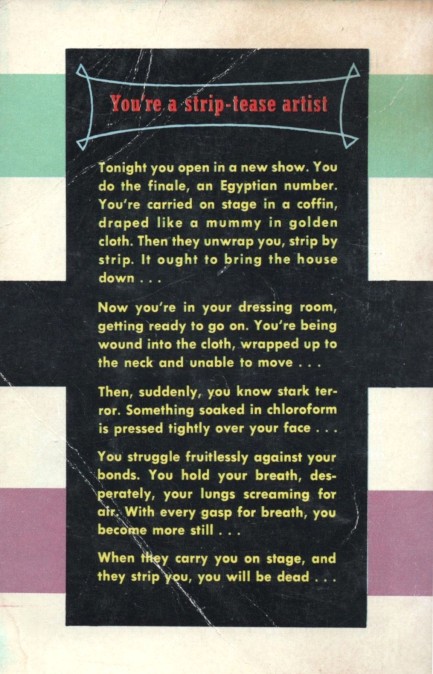




























 One day there will be no more Charles Williams for us to read, and that'll be sad, but his books, like good wine, are something you have to treat yourself to regularly even as the stock dwindles. His 1958 novel All the Way, which is the source material for the 1960 movie The 3rd Voice, is typically solid Williams work.
One day there will be no more Charles Williams for us to read, and that'll be sad, but his books, like good wine, are something you have to treat yourself to regularly even as the stock dwindles. His 1958 novel All the Way, which is the source material for the 1960 movie The 3rd Voice, is typically solid Williams work.













































































